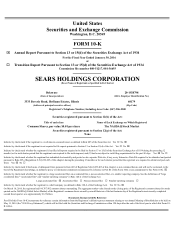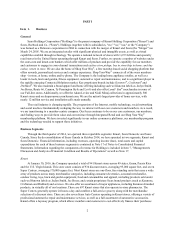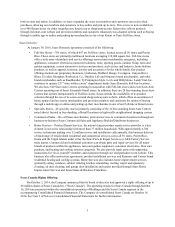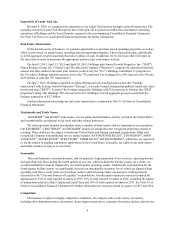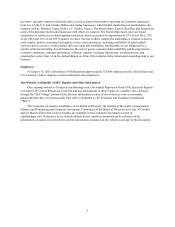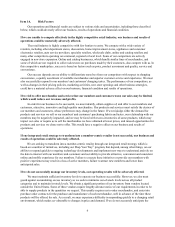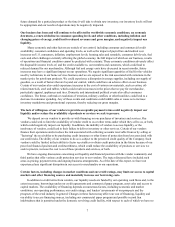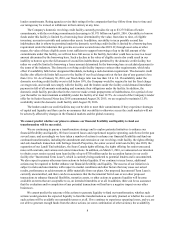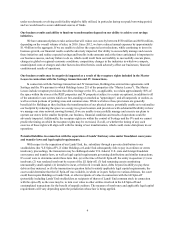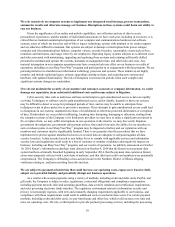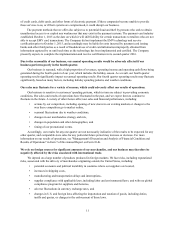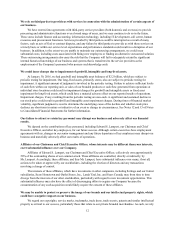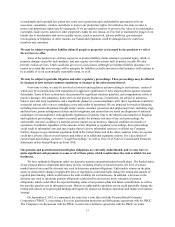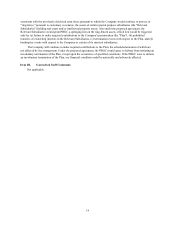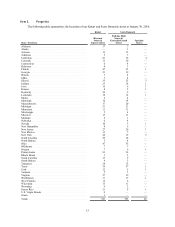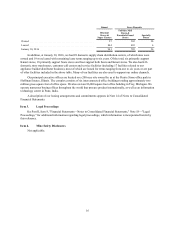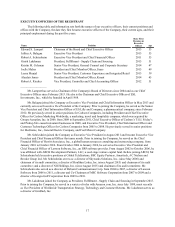Sears 2015 Annual Report Download - page 7
Download and view the complete annual report
Please find page 7 of the 2015 Sears annual report below. You can navigate through the pages in the report by either clicking on the pages listed below, or by using the keyword search tool below to find specific information within the annual report.
future demand for a particular product or the time it will take to obtain new inventory, our inventory levels will not
be appropriate and our results of operations may be negatively impacted.
Our business has been and will continue to be affected by worldwide economic conditions; an economic
downturn, a renewed decline in consumer-spending levels and other conditions, including inflation and
changing prices of energy, could lead to reduced revenues and gross margins, and negatively impact our
liquidity.
Many economic and other factors are outside of our control, including consumer and commercial credit
availability, consumer confidence and spending levels, as well as the impact of payroll tax and medical cost
increases on U.S. consumers, inflation, employment levels, housing sales and remodels, consumer debt levels, fuel
costs and other challenges currently affecting the global economy, the full impact of which on our business, results
of operations and financial condition cannot be predicted with certainty. These economic conditions adversely affect
the disposable income levels of, and the credit available to, our members and customers, which could lead to
reduced demand for our merchandise. Although fuel and energy costs have decreased in recent months, future
increases may have a significant impact on our operations. We require significant quantities of fuel for the vehicles
used by technicians in our home services business and we are exposed to the risk associated with variations in the
market price for petroleum products. We could experience a disruption in energy supplies, including our supply of
gasoline, as a result of factors that are beyond our control, which could have an adverse effect on our business.
Certain of our vendors also could experience increases in the cost of various raw materials, such as cotton, oil-
related materials, steel and rubber, which could result in increases in the prices that we pay for merchandise,
particularly apparel, appliances and tires. Domestic and international political events also affect consumer
confidence. The threat, outbreak or escalation of terrorism, military conflicts or other hostilities could lead to a
decrease in consumer spending. Any of these events and conditions could inhibit sales or cause us to increase
inventory markdowns and promotional expenses, thereby reducing our gross margins.
The lack of willingness of our vendors to provide acceptable payment terms could negatively impact our
liquidity and/or reduce the availability of products or services we seek to procure.
We depend on our vendors to provide us with financing on our purchases of inventory and services. Our
vendors could seek to limit the availability of vendor credit to us or other terms under which they sell to us, or both,
which could negatively impact our liquidity. In addition, the inability of vendors to access liquidity, or the
insolvency of vendors, could lead to their failure to deliver inventory or other services. Certain of our vendors
finance their operations and/or reduce the risk associated with collecting accounts receivable from us by selling or
"factoring" the receivables or by purchasing credit insurance or other forms of protection from loss associated with
our credit risks. The ability of our vendors to do so is subject to the perceived credit quality of the Company. Such
vendors could be limited in their ability to factor receivables or obtain credit protection in the future because of our
perceived financial position and creditworthiness, which could reduce the availability of products or services we
seek to procure, increase the cost to us of those products and services, or both.
We have ongoing discussions concerning our liquidity and financial position with the vendor community and
third parties that offer various credit protection services to our vendors. The topics discussed have included such
areas as pricing, payment terms and ongoing business arrangements. As of the date of this report, we have not
experienced any significant disruption in our access to merchandise or our operations.
Certain factors, including changes in market conditions and our credit ratings, may limit our access to capital
markets and other financing sources and materially increase our borrowing costs.
In addition to credit terms from vendors, our liquidity needs are funded by our operating cash flows and, to the
extent necessary, borrowings under our credit agreements and commercial paper program, asset sales and access to
capital markets. The availability of financing depends on numerous factors, including economic and market
conditions, our operating performance, our credit ratings, and lenders' assessments of our prospects and the
prospects of the retail industry in general. Changes in these factors may affect our cost of financing, liquidity and
our ability to access financing sources, including our commercial paper program and possible second lien
indebtedness that is permitted under the domestic revolving credit facility, with respect to each of which we have no
7

